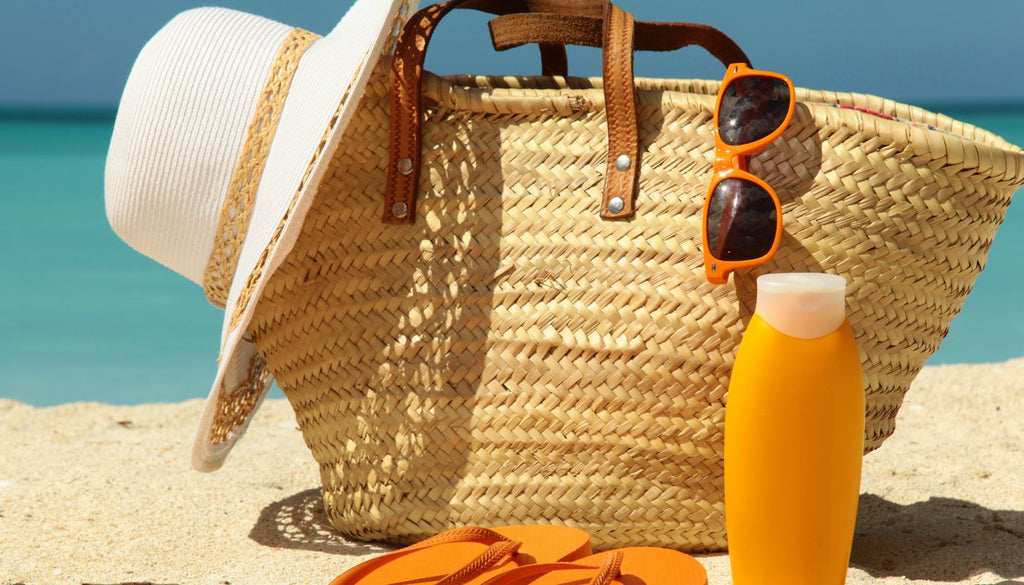
Sun protection isn't just about sunscreen
I grew up in Queensland, and although my mum was pretty careful about making us wear sunscreen (remember fluorescent zinc?) and a tshirt, awareness about the dangers of too much sun just wasn’t as widespread as it is today. Both my brothers and I are now hyper-vigilant about sun protection, as we are all in our forties and have all had melanomas (fortunately benign) cut out. In fact, I’m so vigilant about sun protection that I was recently diagnosed with a Vitamin D deficiency from not getting out in the sunshine enough! So how do you find a balance between too much sunshine, and not enough?

Protecting Babies from the Sun
Babies under 6 months don’t belong in the sun. They don’t need sunscreen, because they shouldn’t be exposed to sunlight. Babies’ skin doesn’t have melanin (tanning pigments) which protect skin.
- Babies need a hat.
- Babies need to have clothing that covers them up.
- Babies should be kept in the shade.
Be careful of the shade, too, as putting a baby under a tree might still mean that their sensitive skins get burnt because of the way sunlight filters through leaves. Start your baby wearing a hat from a very young age, and they’ll soon get used to it and not pull it off every time you put it on. It’s a good idea to get a hat with a brim all around to protect ears and necks, rather than a cap style which only protects the face.
Children and Sun Protection
Choose your own sunscreen, and send your child to school with this. Make sure you reapply sunscreen frequently, especially if children are swimming or sweating a lot. Make sure your children have a good rash vest for swimming.
Adults and Sun Protection
Be good role models – make sure your children see you covering up with clothing, sunglasses and hats. Follow our four top tips, and make sure that your children do, too.
1. Avoid the sun during the hottest part of the day
Recent research has shown that morning sunshine is better for you than afternoon sunshine, so get out into the garden in a tshirt and peg the washing out while your little one plays in the garden. Have your morning coffee in the sunshine, or get out and walk the dog early in the day! If you can’t get out in the morning, go out after 3.00. Just ten minutes of sunshine a day, without sunscreen, will get you enough rays to produce Vitamin D to keep you healthy. Going out between 11am and 3pm when the sun is hottest, however, can damage your skin.
2. Cover up with a hat, sunglasses and clothing.
Harsh sunlight can damage eyes, so it’s important that you wear sunglasses. Broad spectrum (UVA and UVB blocking) is best. Babies and children need sunglasses, too. Make sure that they are good quality, and that they fit your child’s face properly. Rash vests are perfect for the beach, as they have a high SPF factor. For getting out and about, cover little arms and legs. This is especially important in the pram, as it’s very easy to forget that your baby’s legs aren’t always protected by the pram shade. There are pram shades specifically designed to shade your baby, so if you’re out with the pram a lot, it may be worth investing in one of these.
3. Find some shade
Sit under a tree, take a gazebo or an umbrella, a beach tent – anything that will keep you out of the direct sunlight.
4. Sunscreen is your last line of defence against getting sunburnt
While it is essential to wear sunscreen when you’re in the sun, remember that sunscreen is you’re your first defence against getting sunburnt. Sunscreen is a filter, not a block.
Choosing A Good Natural Sunscreen
There are a few specific chemicals often used in sunscreens that are best to avoid:- retinyl palmitate – a form of Vitamin A that may speed up the growth of skin tumours.
- Oxybenzone – a hormone disrupter
- Added insect repellant – buy insect repellant separately, and apply it before you apply sunscreen
- Parabens
- Phthalates – fragrance (unless it’s from essential oils)
- polyethylene glycols
- propylene glycols
- phenoxyethanol
- SLS and SLES
- Sprays or powders – they may sound convenient, but you don’t want to be breathing these in.
- SPF above 50+
- Zinc
- Titanium dioxide
- Avobenzone or Mexoryl SX
- Cream – rub it in and reapply often
- Broad-spectrum protection – this protects against UVA and UVB
- Water-resistant for beach, pool & exercise
- SPF 30+ for beach & pool
What about micronized particles and nano particles in sunscreens?
Nano particles apparently have the ability to pass through the skin more easily and be absorbed into the bloodstream. There hasn’t been a lot of testing on nano-technology and it’s impact on human health, but it’s thought that nanoparticles produce free radicals and damage DNA, particularly when exposed to UV light. Until more research has been done, it’s best to avoid nano-particles. However, it’s better to wear sunscreen with nano-particles than no sunscreen at all. It’s not established whether there is a problem with nano-particles, but it’s very well established that exposure to the sun causes skin damage and cancer!





